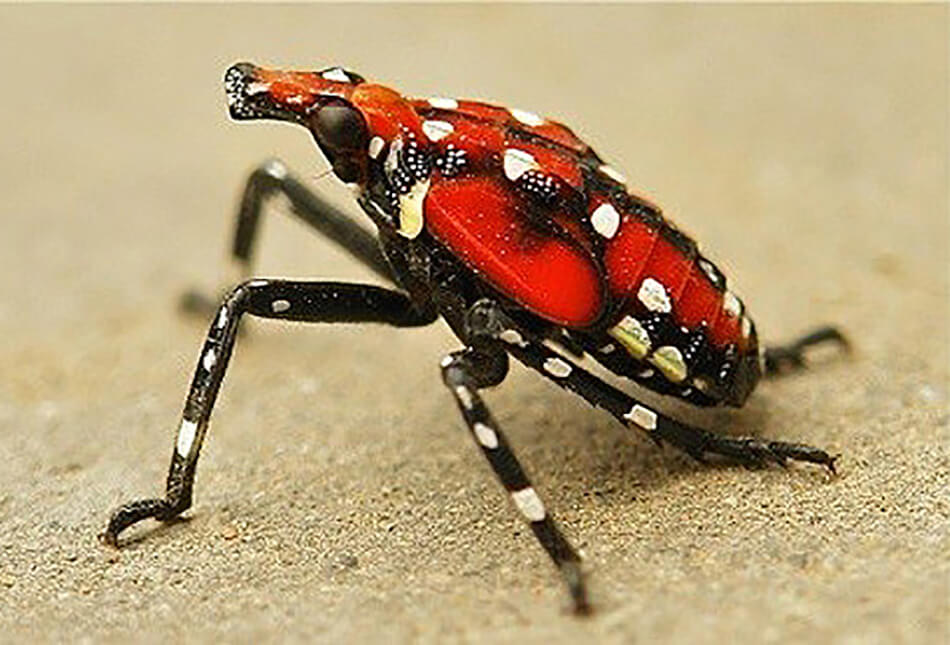The scourge of Pennsylvania has finally descended upon New Jersey, and everyone’s talking about it: the Spotted Lanternfly.
If you’re not familiar with this bizarre-looking plant hopper, it is an inch-long true bug native to Asia, that started appearing in the Pennsylvania area about 5 years ago.
It is a destructive, invasive species that wreaks havoc on local agriculture.
So what exactly does it do and why does it pose an environmental health hazard?
Delicate Ecosystem
In case you haven’t noticed, the ecosystem in many parts of the country is already breaking down.
Trees everywhere are incurring blights and diseases, insects like dragonflies, ladybugs, and bees are vanishing en masse, water pollution is rampant, and weather patterns are getting more extreme.
Environmental breakdown and climate change are realities that are impossible to ignore at this point.
For farmers and gardeners, this balance is all too important, and the spotted lanternfly may throw a wrench in an already malfunctioning gear system.
The problem with this insect is that it tends to feed on the sap of many kinds of plants and trees. Alone, they don’t really seem harmful, but that’s the problem. Since they are an invasive species, they have no natural predators here. Their numbers are burgeoning out of control, and in giant masses, they descend on crops and orchards, absolutely decimating the crops.
They attack many kinds of popular plant species, including apples and grapes, as well as hardwood trees like walnut. Farmers say that this bug is already having a massive financial impact in Pennsylvania, and New Jersey is on red alert.
Quarantines and Memes
So bad is the problem with this bug, that multiple counties in Pennsylvania and New Jersey have quarantines in effect, which regulate and limit transport between counties. This is all in an attempt to limit the spread of the insect in hopes that by raising enough awareness, its numbers will be curtailed.
It’s becoming apparent by looking at social media that the problem with these critters is escalating rapidly since the start of the 2019 summer.
Spotted Lanternfly vs. Pennsylvania: The Bug Is Winning. @mollysbethlehem featured in @WSJ #lehighvalley #spottedlanternfly https://t.co/onlp2ISnlA
— LehighValleywithLove (@LVwithLove) September 18, 2019
Practicing for "Squish a Spotted Lanternfly day" on September 22nd. ????????????#spottedlanternfly #spottedlanternflies #squishaspottedlanternflyday #environment #Pennsylvania #mensdressshoes #spottedlanternflystomp pic.twitter.com/Y8SGyLxOlm
— Chase Hardy (@HardwiredDude) September 18, 2019
A Brooklyn cargo ship was placed under quarantine because it carried a #spottedlanternfly #NYC https://t.co/IBkAO3vs55
— Metro New York (@metronewyork) September 17, 2019
Just got my first kill of a #SpottedLanternfly. That crunch is satisfying.
— Dennis Coleman (@denniswcoleman) September 17, 2019
Under normal circumstances, local governments rarely put out calls to destroy a certain insect on sight, but at the moment, authorities say this is an all-hands-on-deck kind of situation. If you are to see a spotted lanternfly, you are to report the location to the Department of Agriculture and collect or kill if possible.
This includes the egg masses, which are typically laid on host trees. Because of the numerous problems that both the adult lanterfly and the larve pose, the government isn’t taking any chances.
As the summer wains, there will be fewer sightings of the bug. They can only survive as eggs over the course of the winter.
These kinds of dangerous invasive species have the potential to shatter an already struggling ecosystem. Do your part and report sightings of the spotted lanternfly in your area.
Photo courtesy of www.aphis.usda.gov

